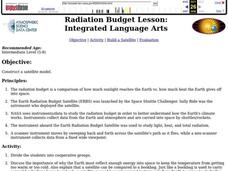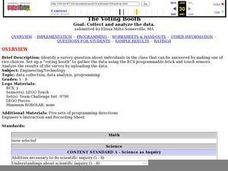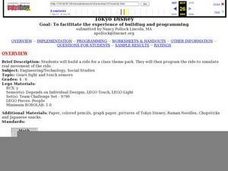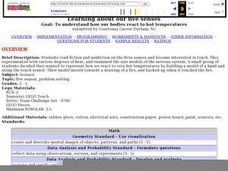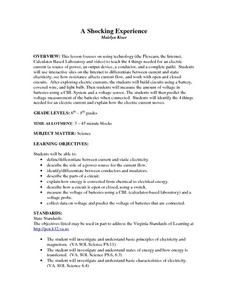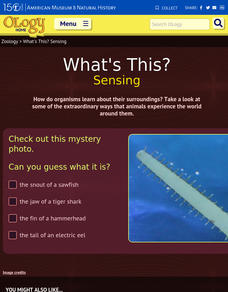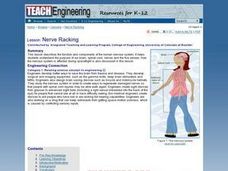Curated OER
Comparing Sunscreens
Twelfth graders use a microcomputer connected to an ultra-violet sensor to compare the relative blocking power of different SPF sunscreens for the UVB region of the solar spectrum.
Curated OER
Radiation Budget
Students examine the radiation budget and the launching of the Budget Satellite. They role-play as designers of the satellite and construct one with a power source, instruments, and sensors. they explain how their satellite functions...
Teach Engineering
Catching the Perfect SAR Waves!
Zero in on an interesting resource involving radar technology. Groups construct a radar sensing unit and learn to calibrate the system. Using the radar system and the Pythagorean Theorem, they calculate distances between objects.
Teach Engineering
All Fats Are Not Created Equal
Apply robotics to connect physical properties to chemical properties. Future engineers use robots to determine the melting points of various fats and oils. The robots can do this by measuring the translucency of the fats as they heat up.
Curated OER
The Voting Booth
Pupils construct a "voting booth" to gather data using RCX programmable brick and touch sensors. They identify a survey question, construct the booth, and analyze the results by uploading data.
Curated OER
Robots Alive: Almost Human
Students explore robotics. They design and draw a robot to fit a specified function. Students examine motor functions necessary for the robot to perform. They discuss types of sensors available to assist in the building of a robot.
Curated OER
Batteries in Series: Voltage and Light Intensity
Learners participate in a hands-on activity to explore the relationship between the number of batteries in a series circuit and its voltage. Students identify the relationship between two variables and plot points on a graph.
Curated OER
Tokyo Disney
Students build a theme park ride with LEGO pieces and program the ride to simulate real movement.
Curated OER
Learning About Our Five Senses
Students study the sense of touch and various degrees of heat. They design a model that displays how the human hand reacts to heat using a touch sensor.
Curated OER
20/20 Vision
Young scholars determine their own eyesight and calculate what a good average eyesight value for the class would be. They examine how technology enhances eyesight and how engineers play an important role in the development of these...
Curated OER
Reflecting on Reflectivity
Learners plan and construct a "mini-lab" to measure the reflectivity of different earth surfaces. They measure reflectivity of materials, including ice, soil, rocks, etc., and then extrapolate from what they have learned to consider the...
Curated OER
Apollo Moon Landing
Students explore paper rockets, learn about the Apollo Program and Apollo spin-offs, and use simple office supplies to design and create a new useful product. This amazing plan is incredibly well written and leads students through a...
Curated OER
A Shocking Experience
Learners differentiate between current and static electricity, conductors and insulators, explain how energy is converted from chemical to electrical, measure voltage of batteries, collect data on voltage, and predict voltage of...
Curated OER
Women's Many Paths to the History Books
As we celebrate Women’s History Month, it’s important to show young women that various female historical figures paved very different ways to the history books.
DiscoverE
My Friend Robot
Can you do better than a robot? Teams write instructions for a hypothetical robot to build a structure. They test their instructions by acting them out to see if they produce the desired structure.
NOAA
The Oceanographic Yo-yo
How does chemistry help deep-sea explorers? Part four of a five-part series of lessons from aboard the Okeanos Explorer introduces middle school scientists to technologies used in ocean exploration. Groups work together to analyze data...
American Museum of Natural History
What's This? Sensing
There is a scallop that relies on sight so much that it actually has more than 100 eyes! There are many species that rely heavily on one sense or another. An online interactive resource has youth read about several of these animals. The...
Curated OER
A Tour of the Solar System
Students construct a spacecraft out of Lego blocks and other materials. They work on their models in small groups while building. They become familar with the planets while working cooperatively.
Curated OER
Protein Biochemistry: Evidence for Charged Amino Acids in Proteins
Students add the acid and base drop wise as the protein precipitates. If either are added too rapidly, students may miss detail or the protein may not have sufficient time to renature. Casein does not buffer the solution well when it is...
Curated OER
Nerve Racking
Fifth graders study the components and function of the nervous system. They investigate how engineers design biomedical equipment to assist the nervous system and explain how the five senses are affected during spaceflight.
Curated OER
Security System Design
Students explain how laser security systems work. In this security system design instructional activity students create a presentation of their system that they designed.
Curated OER
Albedo and Irradiation of Surfaces
Here is a physical science activity where pupils place thermometers inside of a white and a black paper pocket and place them under a lamp. They record and compare the temperature increase over a ten-minute period. Have your class...
Curated OER
Protecting the Mummified Troll
Students develop an invisible security system to protect a mummified troll. In this security system lesson students view a portion of Mythbusters and begin their challenge.
Curated OER
Is there a Lunar Meteorite Hazard?
In this lunar meteorite hazard worksheet, students read about the speed of meteorites that crash into the Moon. Students solve 2 problems including finding the impact rates of the meteorites on the Moon, determining the number of years...

